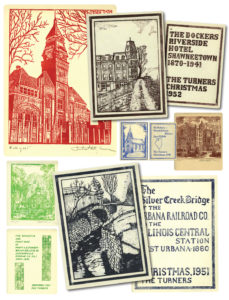Woodblock-print cards etched by alumnus noted as rare collectibles
 Fred Turner (right), UI dean of students, in his office. He and his wife, Elizabeth, used carving tools and woodblocks, inks and brushes, to craft history-themed Christmas cards. Subjects ranged from Jane Addams’ Hull House to the Silver Creek Bridge in Champaign.
Fred Turner (right), UI dean of students, in his office. He and his wife, Elizabeth, used carving tools and woodblocks, inks and brushes, to craft history-themed Christmas cards. Subjects ranged from Jane Addams’ Hull House to the Silver Creek Bridge in Champaign. In this computer-savvy age, even Aunt Martha or Uncle Joe can produce a respectable greeting card. Creating cards worth framing, though, is another matter entirely. From 1946-74, Dean of Students Fred Turner, ’22 LAS, MA ’26 LAS, PHD ’31 ED, and his wife, Elizabeth, used carving tools and woodblocks, ink and brushes, patience and precision, to craft history-themed Christmas cards of such artistic quality that they could be proudly hung on a wall—and today are eminently collectable.
Turner, a Tuscola, Ill., native, first arrived at UI on a dusty June day in 1918. A strike having shutdown the trolley service to the University, the lanky, bes
pectacled freshman had to hoof it the mile or so from the Illinois Central train station in Champaign to campus. Despite this unprepossessing start, Turner came to love the University and ended up devoting most of his life to the school, first as a student, then as dean of men and finally, as dean of students. He held that post from 1943 until his retirement in 1966.
A lifelong history buff, Turner wrote his dissertation on the founding and early history of the University. But a 1944 road trip was to ignite his passion to create historical woodblock prints. Driving through southern Illinois that summer, Turner visited some of the oldest settlements in the state, touring Cahokia, Kaskaskia and other historic sites. Recently reconstructed, the 18th century Fort de Chartres chapel in Prairie du Rocher especially caught the dean’s eye. Gazing at an arched window in the chapel, Turner saw a “possibility for woodblock and Christmas greeting,” as he tersely put it in notes for an early 1970s talk.
Turner made the possibility a reality in 1946 when he and Elizabeth fashioned the first of their soon-to-be-famous Christmas cards. The inaugural card featured the Fort de Chartres chapel window that had so inspired him. By Turner’s own admission, the first woodblock print was a “pretty crude” effort, but over the years his technique improved markedly as he honed his wood-carving skills.
For his early prints, Turner used blocks cut from yellow poplar shelving that, for decades, had stood in the Board of Trustees room in University Hall. He purchased the shelving in 1938, just before the building was razed.
Turner and his wife sent their celebrated cards to 200-plus family members, friends and acquaintances every Christmas for almost 30 years. (In 1951, the cards went out to a record 321 people.) A different Illinois historic site was depicted each year, including the Silver Creek Bridge in Champaign in 1951, Jane Addams’ Hull House in 1963 and the Vandalia State House in 1968. In 1967, the Turners marked the University of Illinois Centennial year with a card portraying University Hall, Altgeld Hall and the Illini Union.
Turner died in 1975 at age 75, but his woodblock prints remain in demand.
“Today, more than 30 years after their passings—Mrs. Turner died in January 1978, at age 76 years—the Turners’ prints find ready buyers on the antiques-collectibles market on those rare occasions when they come up for sale,” Bruce Wood, a trustee of the Champaign County Historical Museum, noted in 2009, according to an article in The (Champaign-Urbana) News-Gazette.
So, keep an eye on eBay. You can never tell when a Turner woodblock print might pop up!


